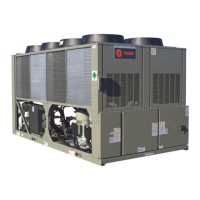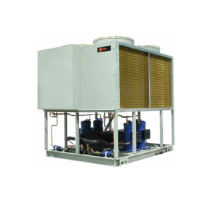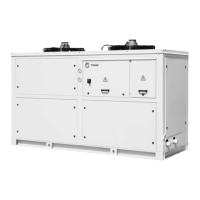CG-SVX17D-EN 151
Unit Start-Up Procedures
Start-Up
CAUTION
Equipment Damage!
Ensure that the oil sump heaters are connected properly and are operating properly for a
minimum of 24 hours before starting. Failure to do so may result in equipment damage.
If the pre-start checkout, has been completed, the unit is ready to start.
1. Press the STOP key on the CH530.
2. As necessary, adjust the setpoint values in the CH530 menus using TechView.
3. Close the fused-disconnect switch for the chilled water pump. Energize the pump(s) to start
water circulation.
4. Check the service valves on the discharge line, suction line, oil line and liquid line for each
circuit. These valves must be open (backseated) before starting the compressors.
CAUTION
Compressor Damage!
Catastrophic damage to the compressor will occur if the oil line shut off valve or the isolation
valves are left closed on unit start-up.
5. Press the AUTO key. If the chiller control calls for cooling and all safety interlocks are closed,
the unit will start. The compressor(s) will load and unload in response to the leaving chilled
water temperature.
6. Verify that the chilled water pump runs for at least one minute after the chiller is commanded
to stop (for normal chilled water systems).
Note: Once the system has been operating for approximately 30 minutes and has become
stabilized, complete the remaining start-up procedures, as follows:
7. Check the evaporator refrigerant pressure and the condenser refrigerant pressure under
Refrigerant Report on the CH530 TechView.
Note: The pressures are referenced to sea level (14.6960 psia). This value is adjustable in
TechVie w.
8. Check the EXV sight glasses after sufficient time has elapsed to stabilize the chiller. The
refrigerant flow past the sight glasses should be clear. Bubbles in the refrigerant indicate either
low refrigerant charge or excessive pressure drop in the liquid line or a stuck open expansion
valve. A restriction in the line can sometimes be identified by a noticeable temperature
differential between the two sides of the restriction. Frost will often form on the line at this point.
Proper refrigerant charges are shown in the General Data tables.
Note: Important! A clear sight glass alone does not mean that the system is properly charged. Also
check system subcooling, liquid level control and unit operating pressures.
9. Measure the system subcooling.
10. A shortage of refrigerant is indicated if operating pressures are low and subcooling is also low.
If the operating pressures, sight glass, superheat and subcooling readings indicate a refrigerant
shortage, gas-charge refrigerant into each circuit, as required. With the unit running, add
refrigerant liquid charge slowly thought the suction line service valve until operating conditions
become normal.
Print out a Chiller Service Report from TechView to file a start-up claim and to keep for reference
with the chiller.












